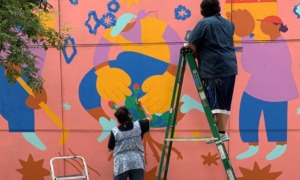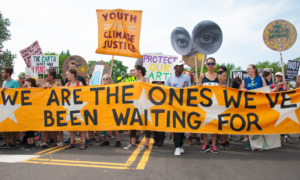
Alex Holyoake /Unsplash
.
Toni should be celebrating. She’s part of a rarified group — the 10 percent of students at four-year public colleges who graduate with their bachelor’s degree on time. Even more significantly, she has already cemented herself as one of only 3 percent of foster youth to achieve a four-year degree by age 26, compared to nearly 50 percent of her nonfoster peers.
But she is not celebrating, or preparing for her graduation day or attending on-campus recruitment fairs. Toni is spending every minute of every day looking for a place to live because she has turned 21 and her time in foster care, the system she grew up in, is over. She is completely on her own with no family supports and has only a few days to move out of her dorm. Right now, it’s a move to homelessness.

Jill Bloch
Toni’s situation is the norm for young adults who have been in foster care. Securing safe, affordable housing is a common problem for many vulnerable populations, but housing instability and the risk of homelessness is greatest for young adults aging out of the foster care system. Successful young adults like Toni can plummet off the emancipation cliff, and the likelihood they will ever recover, no matter how talented and driven they are, is slim.
More than 20,000 youth between the ages of 18 and 21 “age out” or emancipate out of foster care every year without finding a forever family. Tragically, 25 percent of these young adults will experience homelessness within the first year of leaving foster care, and 50 percent of these youth will be homeless within the first four years. By comparison, the National Longitudinal Study of Adolescent Health found that only 4 percent of young adults ages 18 to 26 reported ever being homeless. The result of foster youth being more than 10 times more likely to be homeless than their peers is a continued cycle of unfulfilled potential and a burden to society of $350 million per year in government assistance, incarceration and lost productivity.
Why is this happening?
Youth aging out of the foster care system do not have the family support system that the average American young adult depends upon as they transition to independence. According to the Pew Research Center, for the first time in more than 130 years, young Americans ages 18 to 34 are now more likely to live with their parents than any other living situation. A third of young people, or 24 million, of those ages 18 to 34, lived under their parents’ roof in 2015. And roughly 50 percent of parents have provided some financial support to at least one adult child in the past year, with 27 percent of these parents providing the primary support. So, while the rest of society is providing more supports, for longer, to young people these days, young people being raised in the foster care system continue to face the brutal reality of being entirely on their own when the system ceases to care for them.
In addition to this emancipation cliff, foster youth are not being prepared to be self-sufficient before they’re required to leave care. Despite services being mandated by federal law to ensure that foster youth are learning self-sufficiency while still in state care, foster youth are not receiving them. For example, according to the Department of Health and Human Services, only 22 percent of eligible youth are provided access to an employment or vocational program, only 28 percent receive post-secondary support and less than 40 percent get budgeting or financial management training or any instruction in managing a home on their own while they are still being taken care of by their state. When less than 50 percent of eligible foster youth are even having their independent living needs assessed, it is no wonder that our youth are failing to thrive on their own after care.
We are making a promise to these youth when they enter foster care that we’ll take care of them, but we are clearly not living up to that promise. If these youth are not provided the skills or opportunities needed to prepare to be on their own, why should anyone be surprised that within four years of aging out, 50 percent are unemployed, those who are employed earn less than $7,500 per year and 70 percent rely on government assistance. And the 3 percent who are like Toni and work so hard to overcome their odds of getting a college degree are at risk of never moving forward to achieve their goals, instead falling into homelessness and the continual cycle of poverty and unfulfilled potential.
What can be done?
We at iFoster believe that the solution is two-pronged to help our young people in foster care achieve self-sufficiency: 1) providing them with a runway, not a cliff, and 2) investing in ensuring they know how to fly when they are handed the controls on the day they age out. The government, funded by our tax dollars, is the legal guardian of each of these young people in foster care, and needs to do more. There are proven solutions in communities across the country that are managing to provide both the runways and flying lessons for foster youth, but the vast majority of youth aging out right now do not benefit from these solutions.
For example, California provides an extended runway with its Transitional Housing Placement Plus (THP-Plus) Program. This program provides subsidized housing on a sliding scale for up to 36 months from age 18 to 24 while investing in educational advocacy and support, job readiness training and life skills training. Since its inception in 2001, the program has proven to be effective at addressing and preventing homelessness. Unfortunately, the program is only funded to serve less than 20 percent of those eligible foster youth in the state, as unlike other child welfare services there is no federal match funding available.
New York City’s Administration for Children’s Services (ACS), City University of New York (CUNY) and The New York Foundling have created The Dorm Project as part of the Fostering College Success Initiative. They observed that despite youth in care doing well in college, these youth were dropping out as they experienced the emancipation cliff at age 21. The Dorm Project provides year-round housing with additional academic, financial, social and emotional supports to any current or former foster youth ages 17 to 24 who is attending any CUNY institution. While it is only in its second year, early results show promise in helping foster youth persist in college. Unfortunately, it too is only a small solution serving only 12 percent of the current and former foster youth in New York state who are attending college.
These examples focus on extending the runway for housing stability, but child welfare systems must also further invest in providing young people with the skills and opportunities they need to take flight. Since October 2008, federal law has required child welfare agencies to work with transition-age youth in developing personalized transition plans. One critical element of every plan is ensuring every youth can earn employment and achieve financial stability upon leaving care. While mandated, less than 3 percent of foster youth participate in the federal government’s largest program to provide job skills or employment services.
iFoster is tackling this head-on by training and supporting foster youth to achieve permanent, competitive employment at living wages prior to exiting care. The iFoster Jobs Program is under evaluation by the federal Administration for Children and Families Services as a promising practice for foster youth employment, a hallmark that could see the model replicated nationwide.
Currently operating in California and New York, with plans to expand to other states, the program has a trauma- and evidence-informed training curriculum to provides the skills needed to get a job and a range of supports to help youth successfully complete training and maintain employment. It also provides direct job placement with more than 25 national employer partners. In its first three years, the program has successfully enabled more than 450 foster youth to earn permanent, living wage employment with a job retention rate that is more than double the industry average. Alumni are successfully graduating college, becoming managers and transitioning to chosen career paths, all while keeping a roof over their heads as they age out of care.
Bottom line, we can do better – the solutions are out there. They need to be adopted and replicated so every one of our youth has the opportunity to fly.
Jill Bloch is the New York director for iFoster, a national nonprofit that launched in 2010. Jill’s 19 years of experience has been committed to ensuring that every child growing up outside of their biological home has the resources and opportunities they need to become successful, independent adults.





























